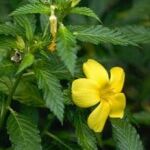| Common Name: |
Damiana |
| Other Names: |
Herba de la Pastora, Mizibcoc, Old Woman's Broom |
| Botanical Name: |
Turnera diffusa |
| Genus: |
Turnera |
| Family: |
Turneraceae |
| Native Location: |
Tropical America |
| Cultivation: |
Dry soil in sun. Cut back in early spring. |
| Propagation: |
By seed sown in spring; by division in spring or autumn; by semi-ripe cuttings in summer. |
| Harvest: |
Plants are cut when flowering, and dried for use in compound mixtures, infusions, liquid extracts, and tablets. |
| Height: |
1m (3ft) |
| :Width |
60cm (2ft) |
| Hardiness: |
Z10-11 |
| Parts Used: |
Whole plant, leaves. |
| Properties: |
A bitter, pungent, warming herb with a fig-like flavor. It improves digestion, lifts the spirits, calms the nerves, regulates hormone function, stimulates the genito-urinary tract, and rejuvenates kidney energy. |
| Medicinal Uses: |
Internally for nervous exhaustion, anxiety, depression, debility in convalescence, impotence, premature ejaculation, prostate complaints, urinary infections, frigidity, vaginal disharge, painful menstruation, poor appetite, menopausal problems, digestion, and atonic constipation. Combines well with Serenoa repens (See, Saw Palmetto) as a tonic for sexual neurosis; with Avena sativa (See, Oats) for depression, and with Scutellaria laterifolia (See, Virginia Skullcap) or Stachys officinalis (See, Betony) for anxiety states.
To treat bladder inflammation, diabetes, kidney ailments, and depression; as an aphrodisiac; to get a mild "high" when smoked and inhaled. |
| Typical Dose: |
A typical dose of damiana may range from 2 to 4 gm of dried leaf taken three times daily. |
| Possible Side Effects: |
There are no known adverse side effects when damiana is taken in recommended therapeutic doses. High doses have been associated with convulsions similar to those caused by tetanus. |
| Drug Interactions: |
| Taking damiana with these drugs may increase the risk of hypoglycemia (low blood sugar): |
| Acarbose, (Prandase, Precose) |
Acetohexamide, (Acetohexamide) |
Chlorpropamide, (Diabinese, Novo-Propamide) |
Gliclazide, (Diamicron, Novo-Gliclazide) |
Glimepiride, (Amaryl) |
| Glipizide, (Glucotrol) |
Glipizide and Metformin, (Metaglip) |
Gliquidone, (Beglynor, Glurenorm) |
Glyburide, (DiaBeta, Micronase) |
Glyburide and Metformin, (Glucovance) |
| Insulin, (Humulin, Novolin R) |
Metformin, (Glucophage, Riomet) |
Miglitol, (Glyset) |
Nateglinide, (Starlix) |
Pioglitazone, (Actos) |
| Repaglinide, (GlucoNorm, Prandin) |
Rosiglitazone, (Avandia) |
Rosiglitazone and Metformin, (Avandamet) |
Tolazamide, (Tolinase) |
Tolbutamide, (Apo-Tolbutamide, Tol-Tab) |
|
| Disease Effects: |
May interfere with control of blood sugar in diabetes. |
| Culinary Uses: |
Dried leaves are used for tea. Extract is used to make liqueur Damiana, which is popular in Mexico as a substitute for Cointreau, or added to hot cinnamon tea. |
| Bibliography: |
Encylopedia of Herbs by Deni Brown Copyright ©: 1995, 2001 Dorling Kindersley Limited pg 395
The Essential Herb-Drug-Vitamin Interaction Guide by Geo. T. Grossberg,MD and Barry Fox,PhD Copyright©2007 Barry Fox,PhD. Pp. 177-178 |

